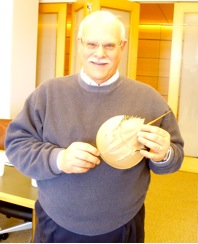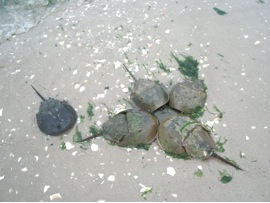The Hudson River Foundation (HRF) is dedicated to scientific research and education that expands the history, culture, and ecology of the mighty, majestic river that runs through 314 miles of New York State.
The HRF offers free monthly seminars to the public to instill both a respect and understanding of this complex waterway. This month's guest speaker, Dr. John Tanacredi, Chairman of the Earth and Marine Science Department at Dowling College, and Director of the Center for Estuarine, Environmental and Coastal Oceans Monitoring (C.E.E.C.O.M) gave us a peek into the adaptations of this ancient creature and current perils that threaten its survival.
and understanding of this complex waterway. This month's guest speaker, Dr. John Tanacredi, Chairman of the Earth and Marine Science Department at Dowling College, and Director of the Center for Estuarine, Environmental and Coastal Oceans Monitoring (C.E.E.C.O.M) gave us a peek into the adaptations of this ancient creature and current perils that threaten its survival.
Over 450 million years of evolution rendered the horseshoe crab a master of survival, including five mass animal extinctions. Equipped with a hard shell, compound eyes that form a mosaic image, and at least 12 simple eyes that are light sensors, the "crab" also has valuable blue blood that coagulates in the presence of toxins. Hence the hunt for this body fluid, which is used as a diagnostic tool for medical and pharmaceutical industries. The blue blood is able to detect spinal meningitis, hepatitis, toxins and other impurities. Dr. Rosen, a medical doctor among the audience of civic leaders, educators and scientists, provided personal testimony mandating by state law the application of horseshoe blood to verify pure conditions during kidney treatments. Historically, Native Americans have used horseshoe crabs as fertilizer, the tails were used as fishing spears, and the shells were used to bail water from canoes. Today, threats to horseshoe crabs include capture for bleeding (they are supposed to be released and returned after limited blood letting), habitat loss, pollution, wastewater discharge, commercial bottom draggers, and bait for eels, conchs, and whelks. There is also some pressure from human consumption, although there is almost nothing to eat on this animal, unlike other true crabs.
Horseshoe crabs have a wide distribution on the Atlantic coast, from Maine to Mexico, and are absent on the west coast in the U.S. Delaware Bay is the hot spot where the population density is the highest. Plum Beach, along the Belt Parkway in Brooklyn, is the major breeding ground in New York. During the months of May and June, precisely synchronized with the new and full moon at high tides, thousands of horseshoe crabs form orgies on the beach to breed. This is also the time for millions of coastal birds to feast on the crabs' little green eggs that abound just beneath the sand. For curriculum material, fact sheets, and scheduled teachers' workshops up and down the Atlantic seaboard, google "green eggs and sand".
to Mexico, and are absent on the west coast in the U.S. Delaware Bay is the hot spot where the population density is the highest. Plum Beach, along the Belt Parkway in Brooklyn, is the major breeding ground in New York. During the months of May and June, precisely synchronized with the new and full moon at high tides, thousands of horseshoe crabs form orgies on the beach to breed. This is also the time for millions of coastal birds to feast on the crabs' little green eggs that abound just beneath the sand. For curriculum material, fact sheets, and scheduled teachers' workshops up and down the Atlantic seaboard, google "green eggs and sand".
Although accurate data is lacking as to the number of horseshoe crabs, possibly 4-10 million exist along the Atlantic coast. Dr. Tanacredi has focused his population inventories from the tip of Brooklyn to the tip of Montauk, indicating that populations have had peeks and falls, but have experienced a net 10% decline over a ten-year period. They are not on the endangered species list, but perhaps they warrant a species of concern status. New York State does not have any ban on the taking of horseshoe crabs as yet, and regulations are relaxed, except in protected areas, such as the Jamaica Bay Wildlife Sanctuary. Should you see a horseshoe crab in trouble, please "flip it" carefully turning it right side up. It just may save your life someday.
For information about the Hudson River Foundation and the schedule of seminars, research projects, and grants, please visit www.hudsonriver.org. The HRF is under the superb supervision of the Executive Director Mr. Clay Hiles.
 and understanding of this complex waterway. This month's guest speaker, Dr. John Tanacredi, Chairman of the Earth and Marine Science Department at Dowling College, and Director of the Center for Estuarine, Environmental and Coastal Oceans Monitoring (C.E.E.C.O.M) gave us a peek into the adaptations of this ancient creature and current perils that threaten its survival.
and understanding of this complex waterway. This month's guest speaker, Dr. John Tanacredi, Chairman of the Earth and Marine Science Department at Dowling College, and Director of the Center for Estuarine, Environmental and Coastal Oceans Monitoring (C.E.E.C.O.M) gave us a peek into the adaptations of this ancient creature and current perils that threaten its survival. to Mexico, and are absent on the west coast in the U.S. Delaware Bay is the hot spot where the population density is the highest. Plum Beach, along the Belt Parkway in Brooklyn, is the major breeding ground in New York. During the months of May and June, precisely synchronized with the new and full moon at high tides, thousands of horseshoe crabs form orgies on the beach to breed. This is also the time for millions of coastal birds to feast on the crabs' little green eggs that abound just beneath the sand. For curriculum material, fact sheets, and scheduled teachers' workshops up and down the Atlantic seaboard, google "green eggs and sand".
to Mexico, and are absent on the west coast in the U.S. Delaware Bay is the hot spot where the population density is the highest. Plum Beach, along the Belt Parkway in Brooklyn, is the major breeding ground in New York. During the months of May and June, precisely synchronized with the new and full moon at high tides, thousands of horseshoe crabs form orgies on the beach to breed. This is also the time for millions of coastal birds to feast on the crabs' little green eggs that abound just beneath the sand. For curriculum material, fact sheets, and scheduled teachers' workshops up and down the Atlantic seaboard, google "green eggs and sand".